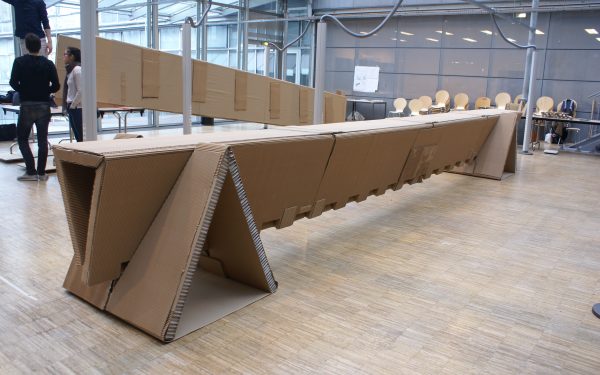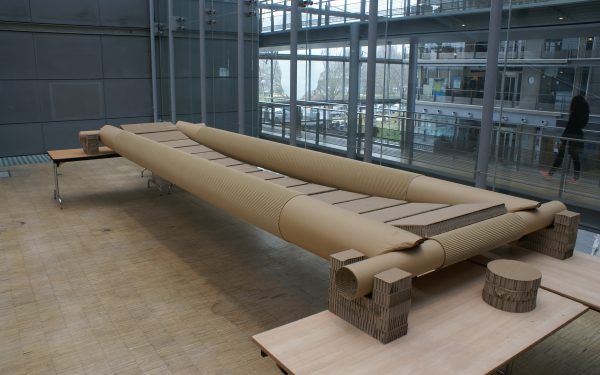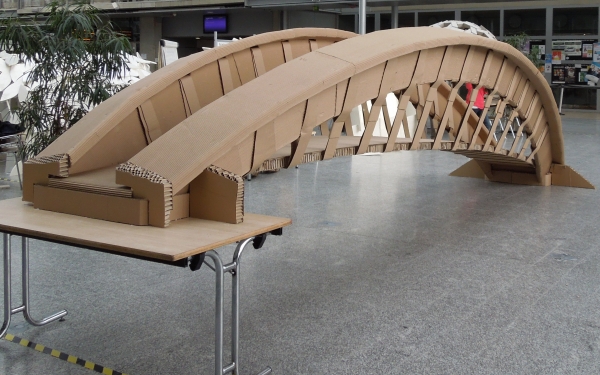@ENPC – Mar. 2015 – A. Lebée, C. Chalumeaux, M. Bernard, P. Lecomte
From design to fabrication in five days… This yearly workshop mixes third year engineering and architecture students in order to design and build a 6m span cardboard footbridge which must carry one pedestrian. They investigate corrugated and honeycomb cardboard strength and versatility as construction materials. Moreover, such a span requires detailed structural analysis and design. In the end, students not only get familiar with all the steps of the design process but make the physical experiment with their own body of the full scale realization.
Objectives
Designing and building a 6m span bridge which can support one person walking. The bridge is made of corrugated cardboard and honeycomb cardboard which may be glued. Students are first in groups of 5 for the preliminary design. Then they are gathered in groups of ten for the construction.
Learning
This intensive workshop is an opportunity for students to work together on a project they build and test in the end. Designing a bridge is indeed a difficult exercise which requires to discover all aspects of civil engineering and architecture. Indeed corrugated cardboard may be a rather strong construction material only if it is cleverly used. A 6m span bridge requires detailed calculation of the load capacity of the bridge and the final test (and failure) of the bridge is a very instructive experience for students
Features of the 2015 edition
For this fifth edition, the workshop took place in “la grande ruche” the open space of Ecole des Ponts ParisTech dedicated to transverse projects. We had four very different footbridges: the Curved Fold Footbridge, the “Pont(zai)” Footbridge, The Monkey Footbridge and the Triangle Footbridge
[flickr_set id=”72157664275818005″ max_num_photos=”6″]
Monkey Footbridge
A monkey bridge or rope bridge is a flexible primitive bridge. Here, the deck is constituted of small honeycomb cardboard plates connected together with a long ribbon of corrugated cardboard. Whereas these bridges are usually anchored in rocks, here the traction at supports generated by the deck is carried by two cylindrical buttons. These buttons have been checked with respect to ultimate capacity of the cross section as well as Euler linear buckling.
Curved Fold Footbridge
This footbridge is foldable from a flat configuration. Once folded, it forms a reversed U-shaped thin walled beam. Detailled analysis was required for the hinges as many layers of corrugated cardboard with different orientations are present.
Pont(zai) Footbridge
This footbridge is the assembly of small U-shaped modules. Detailed design was required for the connection between modules. Traction was easily transmitted by means of cardboard straps. Compression needed reinforcing inserts in honeycomb cardbard plates. Shear force and torsion were transmitted thanks to friction between modules.
Triangles Footbridge
This bridge is made of the assemby of numerous triangular modules and looks like a truss bridge.
It could not carry any load, even its self weight… try to find out why…!
Team
Teachers: A. Lebée, C. Chalumeaux, P. Lecomte, M. Bernard
Monkey Footbridge: Cindy Cotonea, Baptiste Durand, Thomas Guilbaud, Thibault Jauffrineau, Adrien Le Franc, Clara Lesbros, Antoine Lespagnol, Antoine Montiel, Clara Oozeer, Marc Tasso.
Curved Fold Footbridge: Nicolas Berrebbi, Théo Biancone, Lucien Chassin, Alicia Gauthier, Lucie Gustin, Maxime Heinrich, Michel Kowalewski, Sum Leng Lee, Raphaël Levy, Jeanne Zagury.
Pont(zai) Footbridge: Pierre Bastard, Jessica Bismuth, Nicola Bronzetti, Adèle Gillier, Thomas Godey, Adrien Leroy, Laure Martel, Alexiane Murino, Mathieu Pichon, Yann Souk.
Triangles Footbridge: Fabien Chaillard, Sabine Cormier, Hongyang Ding, Henri Isaac, Nicolas Leoni, Max Louyot, Lana Mordrelle, Roman Sureau, Cécile Taquet Gasperini.




